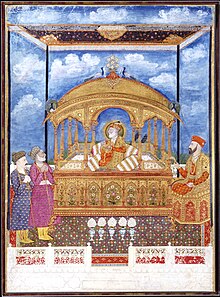Ghulam Qadir
Ghulam Qadir (G̲h̲ulām Ḳādir Rohilla; *? In?; † March 3, 1789 near Meerut ), was a leader of the Afghan Rohilla at the time of the Mughal Empire . He was best known for blinding Shah Alam II .
Life
Ghulam Qadir was a son of Zabita Khan (Ḍābiṭa Ḵh̲ān). After the death of his father Najib-ud-Daula on October 31, 1770, Zabita Kahn took over the leadership of a branch of the Afghan Rohilla.
Captivity in Qudsiya Bagh
After several rebellions by the Rohillas, Shah Alam II launched a campaign against Zabita Khan under the Maratha leader Mahadaji Shinde (Mahādd̲j̲ī Sindhiyā), during which the eight to ten-year-old Ghulam Qadir was captured as part of the family of Zabita Khan on February 24, 1772, while Zabita Khan escaped herself.
After his capture, Ghulam Qadir was taken to Delhi. There he grew up in a "golden prison". Shah Alam II called him his son ( farzand ) and granted him the title "Raushan-ud-Daula". The Mughal emperor even wrote about him. Some of these poems have survived. Sometimes it is also reported that Ghulam Qadir was castrated while he was in captivity. This is denied by William Dalrymple , arguing that Ghulam Qadir is described as bearded in later contemporary sources.
Looting of the Red Fort
After the death of Zabita Khan, Ghulam Qadir - long freed from his captivity - led the Rohillas. At about the age of twenty he began a campaign against Shah Alam II. He camped in Delhi and moved with 2,000 fighters in front of the Red Fort . There the Nazir opened the gates of the fort against the will of Shah Alam II and let Ghulam Qadir and his fighters in. In this way Ghulam Qadir managed to occupy the Red Fort. His occupation lasted from July 18 to October 2, 1788. During this time Ghulam Qadir deposed Shah Alam II on July 30, 1788 and Bedar Shah as the new Mughal emperor.
Ghulam Qadir led a reign of terror in the Red Fort, during which Shah Allam II was blinded on August 10, 1788 and the other Timurids were also tortured. The women of the harem are said to have starved to death and imperial princes were flogged. Troops led by Mahadaji Shinde and Begum Samru later liberated the Red Fort and reinstated Shah Alam II as Mughal emperor.
Escape and execution
Ghulam Qadir fled with his troops and was surrounded on December 12, 1788 by soldiers of the Begum Sumru in Meerut . Ghulam Qadir managed to break through the encirclement during the night with 500 riders. During his outbreak, however, he lost sight of his entourage and later had to go to the house of a Brahmin who recognized him. Mahadaji Shinde was informed of this and had the brahmin's house surrounded. He captured Ghulam Qadir on December 18, 1788, and executed him on March 3, 1789 after severe torture. His apples and ears were sent to Shah Alam II.
literature
- Muzaffar Alam / Sanjay Subrahmanyam: Chapter 10: The Political Thought of a Late-Eighteenth-Century Mughal Prince in: Writing the Mughal World: Studies on Culture and Politics, Columbia University Press, New York, 2012, pp. 429-466. JSTOR 10.7312 / alam15810.17 .
- Bazmee Ansari, AS, “ G̲h̲ulām Ḳādir Rohilla ”, in: Encyclopaedia of Islam , 2nd edition 2012. doi : 10.1163 / 1573-3912_islam_SIM_2514 .
- William Dalrymple : The Anarchy: The Relentless Rise of the East India Company , Bloomsbury Publishing, 2019.
- HM Elliot / John Dowson : The History of India, as Told by Its Own Historians. The Muhammadan Period , Volume VIII, London, 1877, pp. 244-254 .
- William Francklin: The History of the Reign of Shah-Aulum, The present emperor of Hindostaun . Cooper and Graham, London, 1798.
- Zahiruddin Malik / Zahiruddin Kalik: Persian Documents pertainig to the tragic End of Ghulam Qadir Rohilla , 1780-1789, in: Proceedings of the Indian History Congress, Volume 43 (1982), 565-471. JSTOR 44141288 .
Web links
- Manu S. Pillai: The Blinding of a Mughal emperor , Livemint, August 30, 2019.
Footnotes
- ^ Athar Ali, M .: Rohillas . In: Encyclopaedia of Islam . 2nd Edition. Brill, doi : 10.1163 / 1573-3912_islam_SIM_6312 .
- ^ A b c Muzaffar Alam / Sanjay Subrahmanyam: The Political Thought of a Late-Eighteenth-Century Mughal Prince. In: Writing the Mughal World: Studies on Culture and Politics . Columbia University Press, New Yoruk, S. 441-444 , JSTOR : 10.7312 / alam15810.17 .
- ↑ a b Bazmee Ansari, AS: "G h Ulam Kadir Rohilla" . In: Encyclopaedia of Islam . 2nd Edition. doi : 10.1163 / 1573-3912_islam_SIM_2514 .
- ↑ William Dalrymple: Tweet of May 4, 2019. In: Twitter. May 5, 2019, accessed June 7, 2020 .
- ^ A b c d William Dalrymple: The Anarchy: The Relentless Rise of the East India Company . Bloomsbury Publishing, 2019, ISBN 978-1-4088-6440-1 .
- Jump up ↑ Zahiruddin Malik / Zahiruddin Kali: Persian Documents pertainig to the tragic End of Ghulam Qadir Rohilla, 1780-1789 . In: Proceedings of the Indian History Congress . tape 43 , 1982, pp. 565 , JSTOR : 44141288 .
- ^ Elliot / Dowson: History of India . tape VIII . London 1877, p. 254 ( archive.org ).
| personal data | |
|---|---|
| SURNAME | Ghulam Qadir |
| ALTERNATIVE NAMES | G̲h̲ulām Ḳādir Rohilla |
| BRIEF DESCRIPTION | Leader of the Rohilla |
| DATE OF BIRTH | 18th century |
| DATE OF DEATH | March 3, 1789 |
| Place of death | at Meerut |

